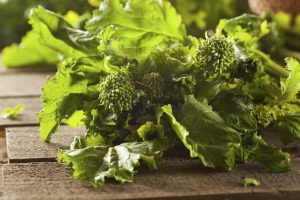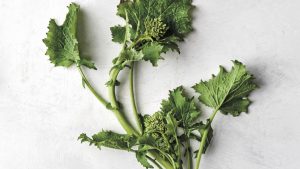
It’s that time of year when lots of delicious, over-wintered vegetables start to produce some of their most interesting offerings. It’s also that time of year when it can start to get a little confusing at the farmers market or grocery store with many of these offerings becoming available all at once. Some vegetables have very similar names and can even look alike, which just ends up confusing the average consumer and can deter people from trying certain vegetables. While all slightly different, these vegetables should never be feared but rather celebrated and explored. So let’s go exploring.One of the most confusing groupings of vegetables this time of year is the delicious family of napini, rapini, and raab. No, you’re not supposed to know the difference between them. In fact, if you search “napini” in Wikipedia, you don’t find a thing. Nothing. But it is a real thing. I promise. At least I think it is. And, although a little bitter, napini is truly delicious and incredibly simple to cook. In fact, all of them are easy to cook, and cook well. Now, if you’re at all like me you see napini, rapini, and raab and you say to yourself “I know they’re different, but I’m not 100% sure how.” Well, in a quest to better understand all of the differences and help you understand all of your options when shopping at the farmers market or grocery store, let’s break them down, and then you can take some home and do just that.
Now, as a disclaimer, I would like to say that there is a lot of information out there. Much of the information I came across was somewhat conflicting, so I have done my best to read, digest, and cross-reference everything to make sure that I’m as accurate as can be. That being said, this is by no means a definitive text on anything, just the end result of my thirst for knowledge being co-opted by my love of food and rabbit holes.
First, the three main characters we are hoping to demystify are napini, rapini, and raab (or rabe). Second, they are all similar to some degree, and many times are used interchangeably. I will not be using them here interchangeably, just as a head’s up. I needed to clutch onto some sanity while writing this so I didn’t get too confused myself. So, here are the definitions we will be working with:
Raab (or Rabe) – the springtime buds, leaves, and flowers of over-wintered brassicas, especially those in the turnip family. These can include collards, kale, brussels sprouts, cabbage, and mustard greens, among others.
Rapini – commonly referred to as broccoli raab or broccoli rabe, though some articles suggested that they were similar but not exactly the same. Either way, rapini is in the same family as turnips and is not the raab of broccoli. It has very similar florets to broccoli, but never forms a single head/mass of florets, and is its own cruciferous vegetable.
Napini – the flowering buds, leaves, and flowers of “bolting” kale. Also known as kale raab. While many varieties of kale will produce napini, it seems that the most common varieties as the Russo-Siberian kales (Brassica napus) which are milder than their European counterparts (Brassica oleracea).
Okay, so does anyone’s head hurt a little? Still processing? Take your time. If you want to get lost in a Wiki-hole, this is a doozie. Especially once you get down to the cultivar level of these species or realize that there isn’t any mention of napini.
So, now that we’ve gotten the hard part out of the way, let’s get into the fun stuff.

DID YOU KNOW…
I’m pretty sure that we covered this section already, but, just for fun lets add some more random knowledge. Rapini as a cultivated vegetable probably descends from a wild herb that was related to turnips growing in either China or the Mediterranean region. Napini will range in color green to purple depending on the variety of kale it is from, but will always turn dark green when cooked.
NUTRITIONAL INFORMATION
Napini and rapini are excellent sources of vitamins A, C, and K, as well as Potassium, Calcium, and Iron. They’re also good sources of complex-B vitamins, manganese, and phosphorous. Other raab (from collards, cabbage, mustard greens, etc.) will be good sources of similar vitamins and minerals, but the nutritional values will differ between species and varieties.
BUYING & STORING
When buying rapini, napini, and raab, (hereafter just referred to as raab to avoid confusion) you should always consider how quickly you’re going to use it. While you can pickle any of them for long-term storage, you don’t want to buy any raab varieties that have open flowers if you aren’t going to use them for a week. Raab with flowers that are starting to blossom won’t last as long as raab with tightly closed buds. That being said, flowering raab is particularly delicious as it tends to be sweeter, so if you find it I suggest trying it. As a note, the green florets are not the flowers. The flowers are typically yellow.
Also, raab is typically found in bunches, so if you aren’t going to use it immediately, avoid bunches that have damaged stems from being tightly rubberbanded or twist-tied as damage to the stem will also cause them to go bad faster. If you can find loose raab, just go all in. When you get it home, keep raab in a plastic bag or wrap it in damp paper towels and keep it in the refrigerator. Please note that if you’re not going to use your raab in the first few days, you’ll have to re-dampen the paper towels. Raab can last up to 1-2 weeks in the refrigerator.
PREPARATION
Raab is incredibly easy to prepare. Wash your raab under running water, and let sit in a colander to dry, if you have one. If you don’t have a colander, just spread the raab out on a towel and let it dry for a little. It does not have to dry completely, just not be soaking. Trim off the bottoms of the stems about ¼ to ½ an inch and remove any damaged stems or parts.
COOKING
All raab is best cooked simply. Some people find raab delicious raw and on its own, but its pungent flavor can overpower a dish so most of the time it is sautéed, roasted, or grilled beforehand to mellow the sharpness just a bit.
Roasting – you can roast raab in the oven anywhere from 375°F to 450°F. This is beneficial if you’re roasting or cooking something else and don’t want to wait until it’s done. Place the whole raab shoots in a bowl, drizzle with olive oil, salt, and pepper (salt and pepper are optional, but a nice touch). Use your hands to toss the raab so that it is very lightly coated in olive oil. No soggy raab here! Spread the raab out on a rimmed baking sheet and roast for about 7-10 minutes. At 425°F the raab should be done in about 10 minutes, so adjust your time accordingly for the temp you’re roasting at – longer for lower temp while turning the raab about every 10 minutes, shorter time for higher temp. Once the raab is tender and the leaves have crisped up, you’re good to go. I suggest dressing the raab with some grated parmesan or other hard, salty cheese, lemon juice, or some apple cider vinegar.
Grilling – when grilling raab, follow the same directions as roasting, just roast the raab over a medium-hot portion of your grill and turn every few minutes to get an even char. Just remember that you’ll want to place the raab across the grill grate (perpendicular), otherwise the thin raab can fall through, and no one wants that to happen.
Sautéing – place a little oil or butter (or fat of any kind) in a skillet or sauté pan over medium-high heat and let it warm. You can also toss the raab with olive oil as you would for roasting if you prefer to oil the raab instead of the pan. Some people do things differently. As long as you have raab, an oil/fat, and a hot pan, we’re all good. Once the pan is hot, drop in the raab and toss or stir it every minute or so until the raab is tender and browned. You can sauté raab as full stems, or chop it up into inch-long sections for use in stir-fry, omelettes, frittatas, pasta, etc. Anything that you would put asparagus in, you can definitely try will any raab, just so long as you’re cool with the bitterness.
Soups – you can also add raab to soups that call for kale or other greens. Typically you’d quickly cook the raab in boiling water then drop it into ice water (also called blanching) which will help to make the stalks tender before adding it to the soup. Some soups may tell you to remove some of the stalk before adding it (which you can always add to a different dish).
Pickling – for long-term storage you can quick-pickle raab and store it in olive oil in the refrigerator. In this form, it is delicious as an appetizer, on a meat and cheese board, or on sandwiches.
You can have a lot of fun with raab, whether it is napini, rapini, or a different variety, you just have to be adventurous and figure out ways to tame the bitterness to your liking. Some raab is less bitter, so ask your farmer if they have varieties that might be more up your alley. Collard raab, for example, has very sturdy stalks but tends to have a more mild flavor. Here are some resources I found in my search, as well as some recipes.
RECIPES:
Roasted Broccoli Rabe (https://cooking.nytimes.com/recipes/1016069-roasted-broccoli-rabe)
Pickled Napini (https://www.thelandconnection.org/blog/mays-here-champaign-farmers-market-starts-one-week)
Pizza with Broccoli Raab, Roasted Onion, and Olives (https://whistlingtrainfarm.com/rapini%E2%80%94its-all-in-the-name/)
Collard Raab & Garlic (https://klesicks.com/collard-raab-garlic-recipe/)
Sautéed Napini (https://grabbingthegusto.wordpress.com/2015/04/25/sauteed-kale-florets-napini/)
INFORMATION:
Gardening Know How – Kale Raab (https://www.gardeningknowhow.com/edible/vegetables/kale/grow-napini-kale-plants.htm)
Wikipedia – Rapini (https://en.wikipedia.org/wiki/Rapini)
The Kitchn – Broccoli, Broccolini, Broccoli Raab, and Chinese Broccoli (https://www.thekitchn.com/whats-the-difference-between-broccoli-broccolini-broccoli-rabe-and-chinese-broccoli-227025)
The Good Stuff NW – Broccolini vs. Broccoli Raab vs. Rapini (http://www.goodstuffnw.com/2014/04/in-season-nw-broccolini-raab-rabe-rapini.html)
Bon Apetit – What is Broccoli Raab (https://www.bonappetit.com/story/what-is-broccoli-rabe)


